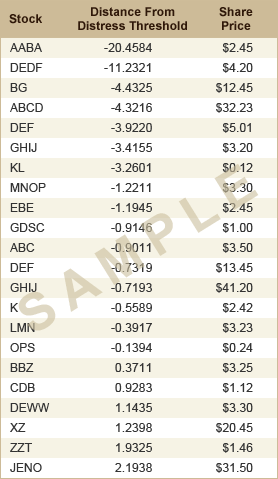Enter a stock symbol
Enter a stock symbol to view that company's Altman Z-Score if it is a manufacturing company, or its Altman Z"-Score, if it is a non-financial, non-manufacturing company, and to view message board posts for that stock (Scores are available for premium members).
Screener
Below is a list of today's twenty-five most distressed stocks (according to their Altman Z-Score or Z''-Score, respectively) with a share price of $5 or higher. For details on how this ranking list is compiled, please click here.



Stock Chart
Flash Player 9 or higher is required to view the chart
Click here to download Flash Player now
MLKNA.PK - Potential accounts receivable flags ALIF.OB vs MLKNA.PK.
These 2 companies IMO share some similarities.
Glance at this table of ALIF.OB and look at accounts receivables:
http://finance.yahoo.c...
Now look at cash in the above link.
Notice Accounts receivables grow and grow while cash doesn't hardly grow.
If you look in filings, you can see the company continued to issue shares to raise cash and keep things running without debt and even give the appearance of growing book value (even got S&P 500's 3M in on a share issuance I believe, what I refer to as Big Dumb Money- basically where so much money belongs to the party that they don't care much if they put a few million in a possible or even likely fraud or scam).
Here's what I have for ALIF.OB's Accts Receivables (approximately)-
2010:
Q3- $31 mill
Q2- $22 mill
Q1- $19 mill
2009:
Q4- $18 mill (AR drops finally-- this would need investigating esp happening at annual)
Q3- $27 mill
Q2- $19 mill
Q1- $17 mill
2008:
Q4- $14 mill
Q3- $10 mill
Q2- $7 mill
Q1- $6 mill
Look! Notice an obvious trend?
Every quarter the company's accounts receivables have grown substantially minus one quarter. When you look at that one quarter, it looked like the accounts receivables were somehow converted into an intangible asset.
Amazingly, the company has been reporting tremendous profits all along and has a PE under 3, is growing profits, book value, and revenues tremendously and consistently if you were to believe the financials, yet has almost no cash at least in relation to ARs. Why is it being valued so 'cheaply'? I don't think it is cheap, I think it is expensive because of risk but let's continue.
Currently, it looks like ALIF is finally having things catch up with them.
http://finance.yahoo.c...
http://finance.yahoo.c...
Now look at MLKNA.PK. To me it looks like a baby ALIF.OB in the making, just starting:
Here's what I have for MLKNA.PK Accounts Receivables:
2010:
Q3- $4.2 mill
Q2- $1.4 mill
Q1- $0.5 mill
2009:
Q4- $0.3 mill
Notice it looks like a countdown starting from most recent quarter? Now in and of itself of course sequential growing accounts receivables isn't necessarily a flag. HOWEVER when ARs consistently grow as fast or faster than revenues, IMO you better bet your hard earned dollars risk is increasing dramatically that something funky is up.
Want to know what MLKNA.PK's revs have done for comparison and see if red flags fly wit this thinking? Ok let's look:
Here's what I have for MLKNA.PK revenues
2010:
Q3- $3.4 mill
Q2- $1.6 mill
Q1- $0.6 mill
2009:
Q4- $0.1 mill
It looks troubling to me, notice ARs are even with or outpacing revenues growth every quarter except Q1 2010 (we can look at that Q to find out if cash was generated on the balance sheet- my guess is it would end up being converted to something intangible like ALIF did in Q4 2009).
If Q4 2010 on MLKNA.PK #s once again show AR growth keeping up with or outpacing revenues growth I would advise people this is looking more and more dangerous. Personally I am thinking that will be the case once the Q4 #s are out for them. The cash raise late in 2010 will help the audit and also further AR growth IMO.
In conclusion, ALIF.OB's history helps teach us what to avoid for risk aversion.
MLKNA.PK is closely following ALIF.OB on the balance sheet in terms of tremendous AR growth, reported profitability, yet cash burn and revenues that can't even keep pace with AR growth.
To me, this is a recipe for dangerous investing. Time will tell.
ALIF.OB has managed to hold on for some time by raising more cash from even the likes of 3M (again see Big Dumb Money definition in beginning).
Maybe MLKNA.PK will also be able to milk things for some time (if they are milking things).
I will definitely watch as part of learning over time.
I have seen this kind of thing before and can not recall an instance where over a long period of time it worked out well for common share investors unless the company gets bought out by big dumb money (always a possibility).
Remember Warren Buffett's rule #1 and #2:
"Rule No.1 is never lose money. Rule No.2 is never forget rule number one."
To follow those 2 important rules, you have to get better at identifying what to stay away from. Staying away from companies consistently growing accounts receivables and also raising more cash are a POTENTIAL flag that deserves more skeptical and critical thinking.
Both ALIF.OB and MLKNA.PK IMO fit this red flag category.
They can easily prove me wrong by posting a nice quarter of revenues that shows a drop in accounts receivables AND some kind of tangible asset like cash growing outside debt/equity raises(remember ALIF managed to change ARs into an intangible asset in Q4 2009), showing they actually are collecting on them.
Good luck and safe investing to people out there. remember to keep a close eye out when accounts receivables grow at or above the rate of revenues for more than one quarter. in this case, i'd keep a close eye on MLKNA.PK and ALIF.OB with ALIF.OB being the one that has dragged this out for some time and MLKNA.PK just getting started.
Either way, I would not put my money at risk on the long side in either company.
Submit a comment
In order to comment please sign in.
Interesting point about watching for the disconnect between accounts receivables growth and revenue growth. Another red flag to watch out for.
They both didn't make their extended deadlines for filing the late 10K either...
Another similarity they share...